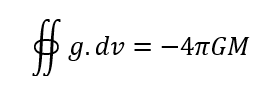Any theory of gravity would need to account for the following observations:
- The acceleration due to gravity of a mass M at a distance r from the mass is inversely proportion to the area of 2-surface at distance r. This follows from the Gaussian formulation of Newtonian gravity, which states that the gravitational flux due to a massive object of mass M on any closed surface surrounding that object is given by the formula
 .
. - The negative potential energy due to gravity of all the particles in the universe appears to be exactly equal to the total energy of all the elementary particles in the universe, at all times.
This, as Lawrence Krauss has argued, makes it possible for the universe to have developed from nothing without violating the law of conservation of energy. Note that QO is the only theory that actually postulates that the universe really developed from nothing. Krauss does not come anywhere near such a statement. - Gravity appears to take the form of a distortion of spacetime, as described by general relativity.
- Stars in spiral arms revolve around their galaxies at more or less the same orbital speed after a given distance from the galactic centre is reached, in apparent contradiction of point 1 (see above).
- Gravitational lensing of light from very distant galaxies around less distant, very massive objects appears to be very much stronger than can be accounted for based on the visible mass of these objects.
The QO account of gravity accounts for all of these observations coherently, with no contrivances.
Mainstream science has two conflicting theories of gravity: General Relativity, in which it is a distortion of space-time, and particle theory, in which it is caused by particles. It is not possible for both of these theories to be true.
